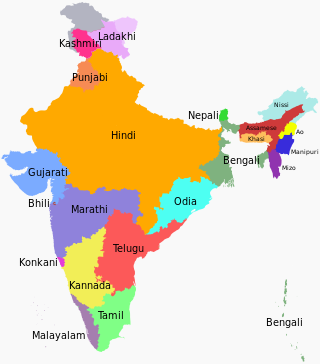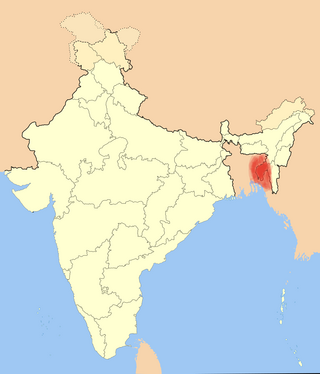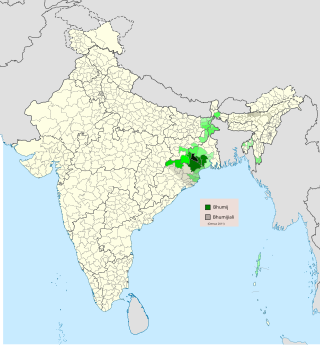Related Research Articles

Languages spoken in the Republic of India belong to several language families, the major ones being the Indo-Aryan languages spoken by 78.05% of Indians and the Dravidian languages spoken by 19.64% of Indians; both families together are sometimes known as Indic languages. Languages spoken by the remaining 2.31% of the population belong to the Austroasiatic, Sino–Tibetan, Tai–Kadai, and a few other minor language families and isolates. According to the People's Linguistic Survey of India, India has the second highest number of languages (780), after Papua New Guinea (840). Ethnologue lists a lower number of 456.

Tripura is a state in Northeast India. The third-smallest state in the country, it covers 10,491 km2 (4,051 sq mi); and the seventh-least populous state with a population of 3.67 million. It is bordered by Assam and Mizoram to the east and by Bangladesh to the north, south and west. Tripura is divided into 8 districts and 23 sub-divisions, where Agartala is the capital and the largest city in the state. Tripura has 19 different tribal communities with a majority Bengali population. Bengali, English and Kokborok are the state's official languages.

There is no national language in the Republic of India. However, article 343(1) of the Indian constitution specifically mentions that "The official language of the Union shall be Hindi in Devanagari script. The form of numerals to be used for the official purposes of the Union shall be the international form of Indian numerals," while article 343(2) allowed for the continuation of English as an official language for another 15 years and 343(3) gave the parliament the power to provide for the use of English language after this period. The clause 3 of the Official Languages Act, 1963 allows for the continued use of English language for official purposes of the Union government and for parliamentary business. Hence Indian English and Modern Standard Hindi are the Official Languages of the Government of India.

Agartala is the capital and the largest city of the Indian state of Tripura, situated on the banks of Haora/Saidra River, about 2 kilometres (1.2 mi) east of the border with Bangladesh and about 2,499 km (1,552 mi) from the national capital, New Delhi. According to 2022 AMC data, Agartala is the third most populous city after Guwahati and Imphal in Northeast India. It is India's third international internet gateway and being developed under the Smart Cities Mission.

Kokborok is a Tibeto-Burman language of the Indian state of Tripura and neighbouring areas of Bangladesh.

The Hindi Belt, also known as the Hindi Heartland, is a linguistic region encompassing parts of northern, central, eastern, and western India where various Northern, Central, Eastern and Western Indo-Aryan languages are spoken, which in a broader sense is termed as Hindi languages, with Standard Hindi serving as the lingua franca of the region.

West Tripura is an administrative district in the state of Tripura in India. The district headquarters are located at Agartala. As of 2012 it is the most populous district of Tripura.

The Bhil languages are a group of Indo-Aryan languages spoken by around 10.4 million Bhils in western and central India as of 2011. They constitute the primary languages of the southern Aravalli Range in Rajasthan and the western Satpura Range in Madhya Pradesh, northwestern Maharashtra, and southern Gujarat. According to the 52nd report of the commissioner for linguistic minorities in India, Ministry of Minority Affairs, Bhili is the most commonly spoken language of the district of Dadra and Nagar Haveli constituting 40.42% of its total population. Bhili speakers are also significant in the states of Gujarat (4.75%), Madhya Pradesh (4.93%) and Rajasthan (4.60%).

Udham Singh Nagar District is a district of Uttarakhand state in northern India. Rudrapur is the district headquarters. This district consists of nine Tehsils named Bajpur, Gadarpur, Rudrapur, Jaspur, Kashipur, Kichha, Khatima, Sitarganj, Nanakmatta. The district is located in the Terai region, and is part of Kumaon Division. It is bounded on the north by Nainital District, on the northeast by Champawat District, on the east by Nepal, and on the south and west by Bareilly, Rampur, Moradabad, Pilibhit and Bijnor District of Uttar Pradesh state. The district was created on 29 September 1995, by Mayawati government out of Nainital District. It is named for freedom fighter and Indian revolutionary Udham Singh.
Bishnupriya Manipuri, also known as Bishnupriya Meitei or simply as Bishnupriya, is an Indo-Aryan lect belonging to the Bengali–Assamese linguistic sub-branch. It is a creole of Bengali language and Meitei language and it still retains its pre-Bengali features. It is spoken in parts of the Indian states of Assam, Tripura and Manipur as well as in the Sylhet Division of Bangladesh. It uses the Bengali-Assamese script as its writing system. Bishnupriya Manipuri, being a member of the Eastern Indo-Aryan languages, was evolved from Magadhi Prakrit. So, its origin is associated with Magadha realm. The Government of Tripura categorised Bishnnupriya Manipuri under the "Tribal Language Cell" of the State Council of Educational Research and Training. Its speakers are also given the "Other Backward Classes" status by the Assam Government and notably, there is no legal status of the Bishnupriyas in Manipur. In the 2020s, the Bishnupriya speaking people started demanding that the Assam Government should give them the status of "indigenous people" of Assam and treat the same like other indigenous communities of the state.
The administrative divisions of India are subnational administrative units of India; they are composed of a nested hierarchy of administrative divisions.

The Mizo language is a Tibeto-Burman language spoken mainly in the Indian state of Mizoram, where it is the official language and lingua franca. It is the mother tongue of the Mizo people and some members of the Mizo diaspora. Other than Mizoram, it is also spoken in Meghalaya, Manipur, Tripura, and Assam states of India, Sagaing Region and Chin State in Myanmar, and Chittagong Hill Tracts of Bangladesh. It is mainly based on the Lusei dialect but it has also derived many words from its surrounding Mizo clans.
Chakma is an Indo-Aryan language spoken by the Chakma and Daingnet people. The language has common features with other languages in the region like the Chittagonian, Tanchangya, Arakanese and others. It has 483,299 speakers in Bangladesh primarily the Chittagong Hill Tracts, and another 230,000 in India, including 97,000 in Mizoram, Tripura and Arunachal Pradesh. It is written using the Chakma script, but literacy in this script is low.
This is a list of States and Union Territories of India by Bengali speakers at the time of the 2011 Census.
Most of the languages of Bihar, the third most populous state of India, belong to the Bihari subgroup of the Indo-Aryan family. Chief among them are Bhojpuri, spoken in the west of the state, Maithili in the north, Magahi in center around capital Patna and in the south of the state. Maithili has official recognition under the Eighth Schedule to the Constitution of India. The official language of Bihar is Modern Standard Hindi, with Standard Urdu serving as a second official language in 15 districts.

Bhumij is an Austroasiatic language belonging to the Munda subfamily, related to Ho, Mundari, and Santali, primarily spoken by Bhumij peoples in the Indian states Jharkhand, Odisha and West Bengal. As per the 2011 census, only 27,506 people out of 9,11,349 Bhumij people spoke Bhumij as their mother tongue, as most Bhumijas have shifted to one of the regional dominant languages. Thus the language is considered an extremely endangered language.

Sipahijala District is a district of Tripura, India. This district was created in January 2012 when four new districts were established in Tripura, taking the number of districts in the state from four to eight. Part of the district was formed from the former district of West Tripura. The principal towns in the district are Bishalgarh, Bishramganj, Melaghar and Sonamura.

The following table contains the Indian states and union territories along with the most spoken scheduled languages used in the region. These are based on the 2011 census of India figures.
Meitei language, the sole official language and the lingua franca of Manipur, one of the scheduled languages of India, one of the recognised educational and literary languages of Assam and Tripura states, has its speakers spread across entire India.
References
- 1 2 "Report of the Commissioner for linguistic minorities: 52nd report (July 2014 to June 2015)" (PDF). Commissioner for Linguistic Minorities, Ministry of Minority Affairs, Government of India. pp. 79–84. Archived from the original (PDF) on 15 November 2016. Retrieved 16 February 2016.
- ↑ kokborokoml.tripura.gov.in/kokborok Archived 28 July 2017 at the Wayback Machine Website of Directorate of bangali and other minority languages, Government of Tripura
- ↑ gomati.tripurapolice.gov.in/ Archived 28 July 2017 at the Wayback Machine Tripura Official Languages Act, 1964, website of Tripura Police Department, Kokborok as official language of Tripura
- ↑ www.tripurauniv.in/index.php/departments?id=400 Archived 25 February 2016 at the Wayback Machine Department of Kokborok, Tripura University, A Central University of Government of India
- 1 2 3 "C-16 Population By Mother Tongue". censusindia.gov.in. Archived from the original on 10 April 2021. Retrieved 28 March 2021.
- ↑ "2011 Indian Census: Language and Mother Tongue". Archived from the original on 11 March 2022.
- ↑ "Every 5th Bengali speaker lives outside Bengal". The Times of India. 28 June 2018. Archived from the original on 21 November 2020. Retrieved 7 January 2021.
- ↑ "Chakma | DIRECTORATE OF KOKBOROK & OTHER MINORITY LANGUAGES". Archived from the original on 9 May 2021. Retrieved 19 May 2021.
- ↑ Milton, Lawrence (17 July 2012). "Saimar's oldest speaker appeals to protect his language". The Times of India . Archived from the original on 11 April 2013. Retrieved 29 March 2013.